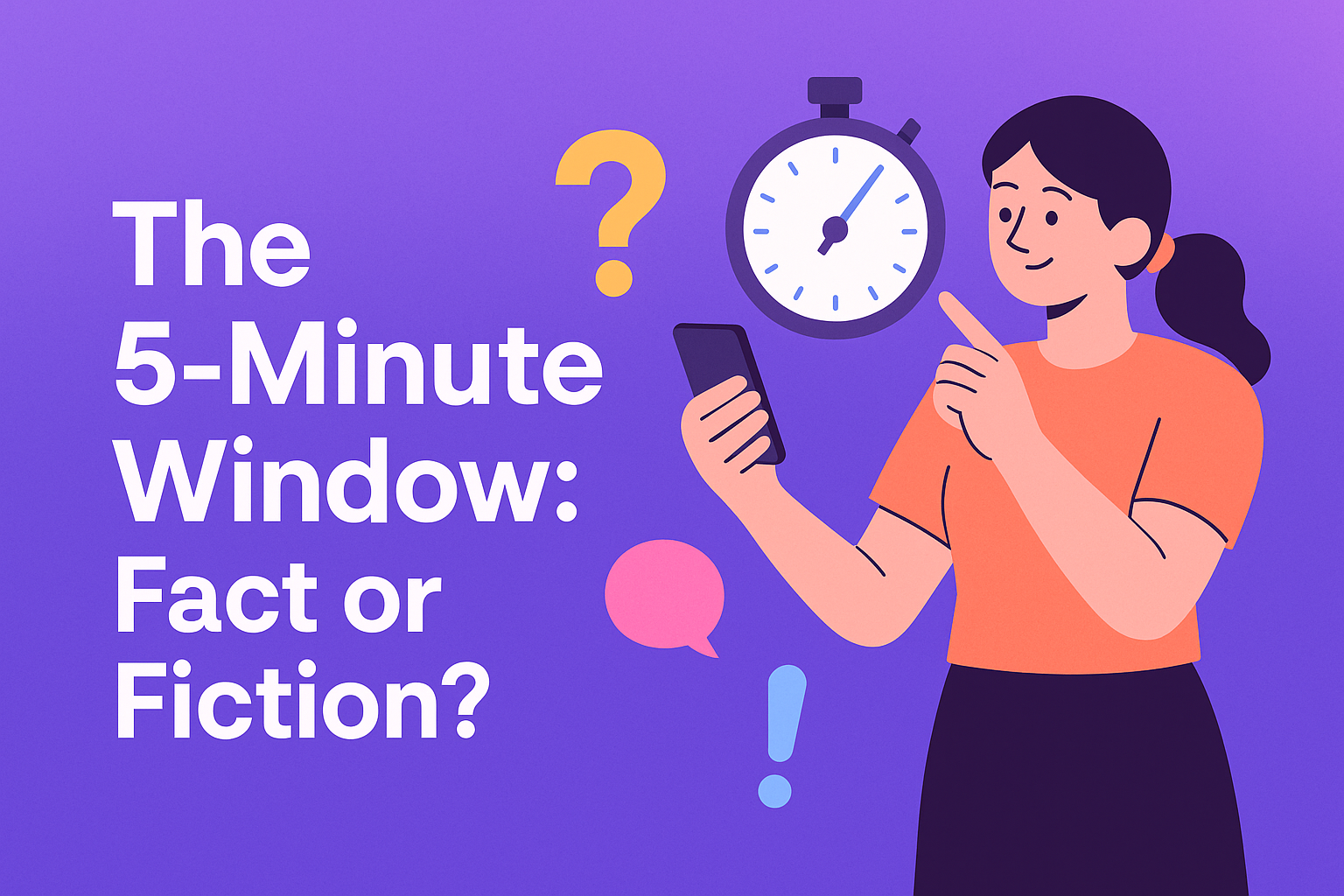In B2B sales, timing isn’t everything — it’s the thing.
When a prospect fills out a demo form or downloads a resource, your sales team has a brief but powerful opportunity to turn that interest into engagement.
That moment — the five-minute window — is where deals are won or lost.
It’s the narrow span of time right after an inbound lead raises their hand, when intent is highest and competition is invisible. Yet for most teams, that window quietly slips away due to slow routing, delayed alerts, or manual follow-ups.
So is the five-minute rule real, or just another sales myth? Let’s break it down.
The Data Behind the Five-Minute Rule
This principle has been studied for over a decade — and the numbers haven’t changed much.
According to research by InsideSales.com (now XANT), reps who contact a lead within five minutes are 100× more likely to connect and 21× more likely to qualify that lead than those who wait just 30 minutes.
Follow-up within that window doesn’t just mean “respond quickly.” It means initiating a live conversation while the buyer is still in research mode, before they move on to another vendor or task.
That’s the real magic of the five-minute window: catching the buyer while they still care.
Why the Five-Minute Window Matters
1. Buyer Intent Fades Fast
Modern buyers don’t browse one vendor at a time. When they fill out your form, they’ve likely done the same on a competitor’s site. If you don’t engage within minutes, someone else will.
2. Momentum Drives Conversion
The longer a lead waits, the more friction builds. Every hour that passes introduces new distractions — Slack pings, meetings, other research — that lower the odds of reply.
3. The Psychology of Urgency
Speed signals competence. When a rep calls or emails within minutes, it tells the buyer: we’re responsive, we’re organized, and we care. Slow response times communicate the opposite.
4. Modern Tools Make It Possible
The argument that “five minutes isn’t realistic” doesn’t hold up anymore. With real-time routing, instant scheduling, and CRM-integrated alerts, speed-to-lead can (and should) be automated.
Why Most Teams Miss the Window
Despite the evidence, the average B2B response time is still measured in hours, not minutes. The reasons are painfully familiar:
- Manual lead assignment delays contact.
- CRM enrichment steps create lag between form fill and rep notification.
- Generic thank-you pages don’t let prospects self-book immediately.
- Disjointed systems mean Marketing, SDRs, and AEs operate in silos.
The result: by the time a rep reaches out, the prospect has gone cold — or worse, scheduled time with a competitor.
How High-Velocity Teams Win the Five-Minute Game
Top-performing GTM teams design their process around one principle: instant engagement.
Here’s how they consistently stay within the five-minute window.
1. Automate Lead Routing
Eliminate manual lead assignment altogether. Tools that use real-time routing rules (by territory, ownership, or account match) ensure leads reach the right rep in seconds, not hours.
2. Embed Scheduling Right After Form Submit
Don’t send prospects to a “thanks, we’ll be in touch” dead end. Instead, let them instantly book time with the correct AE. This turns your form into a conversion engine — and your five-minute window into a five-second one.
3. Trigger Instant Rep Alerts
When a form is submitted, your reps should know immediately — via Slack, email, or CRM notification — who the lead is, where they came from, and what they requested.
4. Layer in Smart Fallbacks
If the right AE isn’t available, route the lead to a backup pool or show alternate time slots. Never make the buyer wait for “someone to reach out.”
5. Measure and Coach for Speed
Speed-to-lead should be a visible KPI. Track how quickly reps respond to inbound leads, identify lag patterns, and coach around them.
What Happens When You Nail It
Companies that master the five-minute rule see results beyond faster response times:
- Higher conversion rates: Leads contacted within minutes convert up to 4× more often.
- Shorter sales cycles: Faster first touch creates earlier qualification and cleaner handoffs.
- Better buyer experience: Prospects remember responsiveness long after the first call.
- More efficient SDR teams: Less manual scheduling, more meaningful conversations.
The best part? You’re not just getting faster — you’re building trust through speed.
Is the Five-Minute Window a Myth?
It’s not fiction — but it’s also not a magic bullet.
Speed alone won’t save a bad process. If your routing logic is flawed or your follow-up is impersonal, fast responses just accelerate failure.
The real takeaway: the five-minute window isn’t about stopwatch speed — it’s about system design.
When marketing, ops, and sales align to eliminate lag from the first touch, response speed becomes automatic. And that’s when the five-minute window stops being a goal — and becomes your default.
Final Thoughts
The five-minute window is real, measurable, and entirely within your control.
It’s not about working harder — it’s about building an infrastructure where “immediate” happens by design.
If your inbound process still depends on manual handoffs or delayed follow-ups, you’re leaking pipeline every day.
Start by mapping your lead flow, finding your lag points, and fixing what slows you down. Because in today’s buyer-driven world, the fastest responder usually wins — and everyone else is already too late.
Let RevenueHero help your team turn high-intent users into booked meeting without slowing down your funnel.













